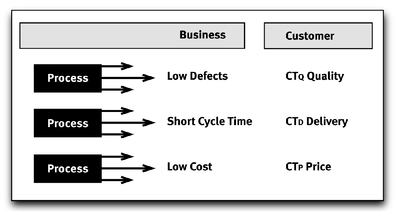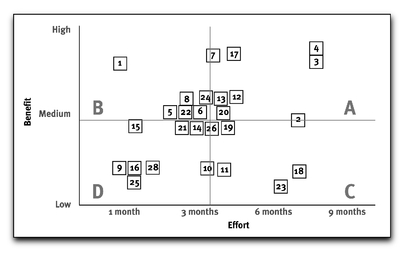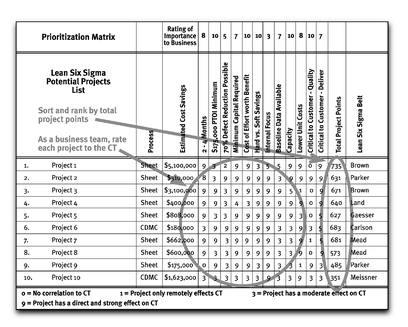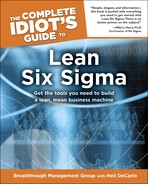Chapter 6
Develop Project Opportunities
In This Chapter
♦ Know what’s critical
♦ The balanced scorecard
♦ Voice of the customer
♦ Keep the good projects
♦ Set your project priorities
Your first task in executing a Lean Six Sigma project is to select a “good” project in the first place. You certainly don’t want to select the most obvious or intuitive project, or the first one that comes to mind. Instead, you’ll want to bring reason and discipline to the way you select your Lean Six Sigma projects.
In this chapter, we’ll guide you through the process of identifying appropriate Lean Six Sigma projects. We’ll look at the factors you should consider in doing so. We’ll give you tools and techniques for gathering project ideas, and for prioritizing the ones that promise to impact your business the most with the least amount of cost and effort.
Figure Out What’s Critical
The first principle you need to get when selecting a Lean Six Sigma project is criticality, meaning you have to select and define a project that is critical to the satisfaction of both your customers and your business. Otherwise, it’s not worth your time, effort, or resources.
So what, then, do we mean by criticality? In Chapter 4, we briefly touched on the concept of CTs. These are the characteristics of your process or product that are “critical to” their success. The chart that follows shows some different types of CTs from both the business and the customer side of the coin.
From a business perspective, it’s critical to focus on low defects, short cycle times, and low cost. Customers, on the other hand, are concerned with quality, delivery, and price.

Compared with CTs for specific products and services, these CTs are very high level. The customer demands high quality, a short order/delivery cycle, and high value for the price. To meet these expectations, the business must provide products and services with low defects, short cycle times, and low costs.
After identifying specific CTs, you (or the leaders of a business) must identify the business processes that control the performance of these business outcomes. In addition, the business leaders must identify the outputs of these critical business processes that are major contributors to the customer-focused CTs.
The Customer View
Let’s consider a bicycle courier service as an example. Many companies in large cities use such point-to-point couriers to deliver important documents to clients. From a customer point of view, what is critical to customer satisfaction?
♦ Quality—Every document must be delivered, complete and intact, to the correct address.
♦ Delivery—The courier must be available to pick up the package and deliver it to the client on very short notice.
♦ Price—While not inexpensive, it must be more cost-effective for the customer to use a courier service than to employ full-time couriers.

Your project ideas should be directly related to what is important to your customers.
To maintain a high-quality business, it’s essential to meet these requirements for the customer. The courier service that best meets these criteria will own the bicycle courier business in the city.
The Business Owner’s View
Taking this a step further, from a courier service owner’s perspective, what are some of the business outcomes that control customer satisfaction? For instance, what business processes are critical to quality? One major defect would be delivering the documents to the wrong address.
On the delivery dimension, you might look at your ability to service clients outside the range of bicycles, or you might have a process for making couriers available on standby if needed. On the price dimension, you’d need to look at how you can best utilize your courier staff, or how you can provide your service with the least amount of support and overhead.
Your project ideas should also be directly related to what is important to your business.

Lean Six Sigma projects for the courier business would be aligned with these CTs. For any organization, the first step of project selection is understanding what’s important to customers and to the business. Only after this are you ready to maximize performance in a way that satisfies both.
Brainstorming Project Possibilities
If you’re in the courier business, you might get some good project ideas from studying the preceding figures. Let’s guess: you’re not in the courier business, but you can still see how identifying all your CTs can put you on the right path in selecting good Lean Six Sigma projects. If you are in the courier business, all the better!
Often, defining your CTs is not enough to help you select the best Lean Six Sigma projects. This is because most business- and customer-level CTs are too broad for a single Lean Six Sigma project. Just to pick up the package at the correct address might require the good functioning of several processes, such as order taking, order entry, and dispatch. All three of these related processes (and others) have to work in flawless coordination to achieve the CT of “pick up (on time) at correct address.”
Therefore, one great way to brainstorm project ideas is to use a CT Flow Down, shown here. This tool is related to “Five Y” analyses, whereby you start with a specific problem and “ask why five times”—all the while probing deeper and deeper into the chain of causation for any CT flow, process, problem, or issue. Following this progression, the upper branches of the CT Tree become your project families, while the lower branches become your individual projects.

A tree diagram is a great tool for breaking down your CTs from the highest level of the business to the lowest level of the process where it makes the most sense to focus a project.
In our courier example, we might have a CT identified: “quickly turn a customer call into a dispatched courier.” We can break this CT down into two more CTs: 1) Having couriers available for dispatch and 2) Relaying accurate information from the customer to the courier. We might further break down each of these two CTs into lower-level CTs where it makes sense to focus a project.
Now you’re generating a lot of project ideas! But remember, more is not always better. You only generate as many ideas as you can at first to make sure you don’t miss any great project opportunities. After this, you’ll go through a weeding-out process for keeping the viable project ideas and discarding the ones that don’t make sense—or that won’t pay off relative to the effort you’ll expend.

Performance Pitfall
Don’t shortcut your way through selecting Lean Six Sigma projects. If you do, you may be disappointed at the results you get. Instead, follow a proven process to pick the right projects from the beginning—and reap the rewards.
More Idea Sources
Sometimes companies don’t have their CTs identified or documented very well. And even if they do, there are many other sources for coming up with project ideas. Hang with us for the next few pages as we summarize some of these ways. There’s really no end to where you can look for good ideas. (Also see Chapter 24 for more ways than we show here.)
The Balanced Scorecard
Developed in the early 1990s by Harvard professor Robert Kaplan and Boston-area consultant David Norton, the Balanced Scorecard is a system of performance metrics. The reason it’s called balanced is because, typically, companies manage themselves by looking in the rearview mirror—at their financial performance as it is reported to Wall Street.
The Balanced Scorecard approach includes the ultimate financial metrics but also includes other important business metrics that lead to healthy financials. Some of these metrics include those in the areas of customer satisfaction, internal business processes, and employee growth and development. The Balanced Scorecard approach connects all these many metrics in a cascading way, from the very top strategic priorities of an organization to its most fundamental operating processes.
The charts that follow show you how this system of performance metrics can lead you to new project ideas at the “actionable process level.” Using a Balanced Scorecard approach to project identification ensures that you pay close attention to opportunities that are in direct support of your company’s top strategic priorities.

Using a Balanced Scorecard to help you generate project ideas will ensure that you’re focusing on what’s most important to your business, employees, and customers.
Voice of the Customer
The success of any organization is directly related to how well it satisfies customers. With unsatisfied customers, no business can survive. With delighted customers, any business can thrive. Therefore, you can use the Voice of the Customer (VOC) to identify project ideas.
The key is to collect the VOC using a valid and repeatable measurement system. By doing so, you start to really understand what your customers think of what you do. As well as you think you know yourself, you will learn what others think, and especially what your customers think. Perhaps more importantly, you will learn about how they feel. Don’t ever forget: customers buy mostly on the basis of emotion. Therefore, some sources of information, or ways to measure your customers’ voice, are:
♦ Complaint systems
♦ Technical support systems
♦ Sales reporting systems
♦ Observations
♦ Focused questioning
♦ Formal customer surveys

Lean Six Sigma Lingo
Voice of the Customer (VOC) refers to the collective needs, wants, and desires of your customer base. The VOC has to be captured, analyzed, and mapped to the processes of your organization—so you can deliver what the customer wants when they want it, in the way they want it.
With this information you can develop performance metrics around customer satisfaction. By monitoring these metrics, you can learn how well you are doing in meeting your customers’ expectations, and you can determine priority areas for improving their satisfaction.
Some of these priorities might include …
♦ Preventing the loss of an existing customer.
♦ Increasing business with an existing customer.
♦ Winning new customers.
♦ Developing new products and services.
Consider the example of a multiscreen movie theater. One of the business measures, of course, is the number of patrons. A theater decides to launch a program to make it the “theater of choice” for the area. A survey is designed to measure the Voice of the Customer.
Some of the survey results for what customers expect are predictable: matinee pricing, online ticket sales, convenient show times. But the theater owner is surprised that two of the larger complaints are dirty bathrooms and sticky theater floors.
Often it pays to listen to the voice of your customers, and to institute a way to capture that voice accurately on a regular basis.

Needless to say, such issues at a movie theater would probably not require the horsepower of a Lean Six Sigma project. But you can see from this simple example how the Voice of the Customer might be helpful in exposing hidden opportunities for improvement.
Value Stream Mapping
Another approach to project identification is using a Value Stream Map (VSM), which depicts how a process operates, with the added dimensions of documenting the people involved, inventory counts, queue times, process cycle times, and lead times. We will delve more deeply into the many functions and parts of a VSM in the Measure phase (discussed in Chapter 10).
For now, all you need is a high-level VSM to help you identify non-value-added activities that unnecessarily consume resources, increase cycle time, and compromise product quality. Such “broken” parts of the process can be good candidates for Lean Six Sigma projects.
Value Stream assessment at the business level focuses on the Value Stream activities, including
♦ The people who perform the task and their knowledge and skills.
♦ The tools and technology used to perform the Value Stream tasks.
♦ The physical facilities and environment in which the Value Stream resides.
♦ The organization and culture of the enterprise that owns the Value Stream.
♦ The values and beliefs that dictate the corporate culture and behaviors that affect the way work is accomplished.
♦ The communications channel and the way information is disseminated throughout the enterprise.
♦ The policies, procedures, and processes that govern the activities of the Value Stream.
♦ The social systems that support the Value Stream.
The way in which all of these aspects are bound together and leveraged to achieve maximum customer satisfaction is the true focus of a Value Stream analysis. When you document and pick apart your Value Stream, you’ll find problematic areas that are in need of improvement. These can become your golden opportunities for Lean Six Sigma projects.
The Bigger Picture
Take a look at this chart, which shows you the many pathways and sources from which project ideas spring. There’s a lot of hints and guidance in here that will help you generate great project ideas.

There are plenty of places you can look to come up with great project ideas. Don’t limit yourself to just one source or another. See the big picture and go from there.
Separate Wheat from Chaff
Once you have all your ideas for projects on the table, you have to weed out the ones you don’t want and keep the ones you do. But don’t jump too fast, and beware of your intuition. While sometimes your gut tells the truth, other times it misleads you. Therefore, you can use a Benefit/Effort Matrix to help you accomplish the important task of separating the wheat from the chaff.
Sometimes called an Impact/Effort Matrix, the Benefit/Effort Matrix enables you to determine which project ideas have the most value and which don’t. Like anything in life, you want to invest in projects and activities that promise to bring you a payoff. When it comes to Lean Six Sigma projects, the Benefit/Effort Matrix makes your decisions easy.

Lean Six Sigma Wisdom
The Benefit/Effort Matrix can be drawn or created using many software packages, including Microsoft Excel or Microsoft PowerPoint.
Preferably working with a team, you build the Benefit/Effort Matrix by ascribing a Benefit scale to the Y axis, and an Effort scale to the X axis, as shown here. For this example, we then ascribe a scale of 1.0 to 5.0 for each axis. For Y, this scale most typically represents the financial benefit you can expect to enjoy from the proposed project.
The Benefit/Effort Matrix helps you count the costs—and predict the outcome—before you commit to pursuing a Lean Six Sigma project.

Often this scale has three range points of low (perhaps $100,000), medium ($500,000), and high ($1 million). But the actual dollar numbers associated depends greatly on your type of organization. A dry cleaner, for instance, might have a different financial definition of low, medium, and high than a jet engine maker.
On the X axis you have a similar three-point system that forms a range for Effort, from low to medium to high. Often, Effort is synonymous with time or personnel or cost. Since different project ideas represent different types of benefits and effort, it’s often best to stick with a generic numerical scale, or the simple low-medium-high scale for both axes.
Populating the matrix is primarily subjective (based on solid team member experience) and, therefore, is only a first-order estimation. Nevertheless, it’s a critical estimation that will save you a lot of time and trouble later. Don’t become bogged down in trying to determine the exact or actual numbers for Benefit/Effort with your team. This will unnecessarily slow down the process at this point.
Take a look at the following Benefit/Effort matrix, which is populated with many project ideas. What can you observe? Immediately you can see projects that are sprinkled all over the matrix. So which ones should you consider implementing and which ones not?
The short, uncomplicated answer—and the basic rule of thumb—is to use the projects in the middle as a relative standard for all the projects under consideration. Clearly, the objective is to disregard all project ideas that fall into the lower-right quadrant: those that require high effort but only yield low results. All other projects become legitimate candidates for Lean Six Sigma projects. And just in case you’ve been dozing, projects in the top left of the matrix are the best candidates—high benefit with low effort.

Using a team process, you can allocate your project ideas into different areas of the matrix. Doing this gives you a great view into which projects are worth pursuing and which are not.
Still, you have more to do in properly defining the most appropriate Lean Six Sigma projects. And a little more to do in deciding which ones you’ll tackle first, second, third, and so on. The good news is that with this list of potential projects you are well on your way to making your process and organization better.

Performance Pitfall
Do not confuse the Benefit/Effort Matrix with a Prioritization Matrix. First you have to determine if a project is worth your time and attention at all (Benefit/Effort); then you need to figure out which projects to pursue right away (Prioritization).
What’s Most Important?
As much as you have to be disciplined about how you generate Lean Six Sigma project ideas, you have to do the same in deciding which project ideas are the best ones to implement. We call this “project prioritization,” and the general rule of thumb is that you should start working on the projects that give you the best buck for your bang.
But what exactly that buck and bang is can be ambiguous if you don’t define it. Like anything in life, you need a set of criteria to guide you. And this is all the more true when you have many people in many different areas of a company all selecting Lean Six Sigma projects at the same time.
Basically, there are three broad criteria by which you can make certain projects a priority and other projects not:
1. Strategically critical: The boss or leadership team deems a project important for the success of the business.
2. Tactically necessary: Customers require that you do something and this puts you in urgent firefighting mode.
3. Methodically determined: A business team decides which projects are a priority based on a structured selection process using a Prioritization Matrix.
Remember that CTs drive much of what you do in a business, including the generation of project ideas. Recall that you have CTs for the business, as well as CTs for customers. Generally speaking, the former are strategic in nature, while the latter are tactical in nature. As shown in the diagram here, the key is to be aware that each of these project types will pay off on different timelines to different degrees.

A good combination of longer and more strategic projects, in addition to some short-term and tactical projects, is preferred because you are capitalizing on critical opportunities today while still working on the keys to success for tomorrow.
The Prioritization Matrix
You’ll want to know this tool well if you want to be intelligent about the way you pick your projects. We all want to be intelligent, right? Well, if you use the Prioritization Matrix properly, you’ll look like the smartest one around. Reason? The matrix enables you to narrow a long list of potential projects down to the ones you want to implement right away.
In the following figure, you can see what a Prioritization Matrix looks like and how you would use it to determine the best projects from a list of possibilities. Here’s how it works:
1. Document business and customer CTs.
2. Rank the CTs against each other.
3. List project opportunities.
4. Estimate bottom-line dollar impact.
5. Identify appropriate resources.
6. Define the scoring criteria.
7. Score opportunities against CTs.
8. Calculate priority numbers and sort by these numbers.
9. Assign resource type to lead the project.
10. Repeat quarterly with business management.

Lean Six Sigma Wisdom
While you may have many Lean Six Sigma project ideas, you can only implement a few at a time. Therefore, you have to pick the best ones first and go from there.
Using the Prioritization Matrix in a team environment enables you to be as methodical as possible in determining where to focus your improvement efforts.

Don’t develop a project Prioritization Matrix once and never look at it again. It should be reviewed and revised at least quarterly to maintain a list of the right projects.
The Least You Need to Know
♦ An organization can only afford to focus its improvement efforts on processes that are critical to customer satisfaction or the viability of the business.
♦ There are many ways to generate Lean Six Sigma project ideas, and many different sources for project ideas.
♦ Two of the most important and useful ways to generate project ideas are through a CT Flow Down and the Voice of the Customer (VOC).
♦ Before you actually choose a Lean Six Sigma project, you have to separate your viable ideas from those that are not worth your time and effort.
♦ You can use a Prioritization Matrix to methodically determine which projects are best to focus on right away.
..................Content has been hidden....................
You can't read the all page of ebook, please click here login for view all page.
